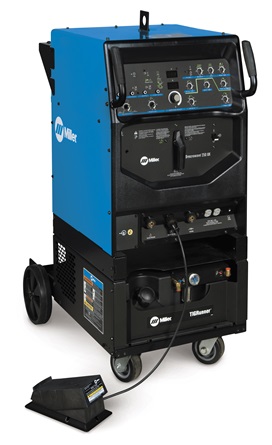Difference between revisions of "TIG Welder"
Jwhipple15 (talk | contribs) |
Jwhipple15 (talk | contribs) |
||
| Line 17: | Line 17: | ||
[[{{#show: {{FULLPAGENAME}}|?Has icon|link=none}}|100px|left|top|{{#show: {{FULLPAGENAME}}|?Has icondesc}}]] | [[{{#show: {{FULLPAGENAME}}|?Has icon|link=none}}|100px|left|top|{{#show: {{FULLPAGENAME}}|?Has icondesc}}]] | ||
[[{{#show: {{FULLPAGENAME}}|?Has image|link=none}}|300px|thumb|upright=1.5|{{#show: {{FULLPAGENAME}}|?Has imagedesc}}]] | [[{{#show: {{FULLPAGENAME}}|?Has image|link=none}}|300px|thumb|upright=1.5|{{#show: {{FULLPAGENAME}}|?Has imagedesc}}]] | ||
| + | |||
| + | The current Ace of the {{PAGENAME}} is '''{{#show: {{PAGENAME}} |?Has ace.Has name}}''' ({{#show: {{PAGENAME}} |?Has ace.Has email address}}).<br /> | ||
| + | __TOC__ | ||
===== Squarewave technology ===== | ===== Squarewave technology ===== | ||
Revision as of 14:14, 19 March 2019
The current Ace of the TIG Welder is Wyatt Bertis (wbertis22@georgefox.edu).
Squarewave technology
Squarewave technology was developed by Miller Electric in 1976 to improve your weld quality and make TIG welding easier. Miller Squarewave technology provides arc stability when welding aluminum, prevents arc rectification and eliminates tungsten erosion.
Balance control
The balance control is adjustable to provide additional oxide removal (more cleaning) or lesscleaning based on the condition of the material being welded.
Syncro Start™
This allows the choice of Soft, Standard or Hot TIG starts based on the application, lead lengths and tungsten size.
Digital welding meters
Display both amperage and voltage for viewing of the actual and preset values for greater accuracy and repeatability in your welding procedure.
Last procedure recall
Simplifies changing your Syncrowave back and forth from aluminum TIG to stainless TIG to Stick welding. One switch makes all the control panel changes.
Adaptive Hot Start™
Stick welding features such as Adaptive Hot Start™ provide good arc strikes without sticking. Once welding, the DIG control makes dynamic adjustments to the welder to ensure smooth E7018 and deep penetration E6010.
Documentation:
https://www.millerwelds.com/files/owners-manuals/O359H_MIL.pdf
Procedure:
- Place the fume hood over the area you will be welding at
- Select electrode that is adequate for your application of material
- Grind electrode to a point. ( This gives a smaller and more directed arc)
- Insert the electrode into the collet of the torch
- Attach ground clamp to table (ensure ground contact surface is clean)
- Ensure the adjusting screw on the tank regulator is loose (Do not unscrew all the way)
- Open cylinder valve all the way
- Turn the adjusting screw (clockwise) to increase pressure to 15 CFH.
- Identify material type, and thickness that is going to be welded
- Refer to TIG welding chart for specified adjustments, specific to your application
- Clean material to remove any oxidizing and or oil residue
- Turn on the welder and adjust----------
- Hold the electrode in your dominant hand ( ensure it can move freely)
- Hold electrode about an inch away from the metal
- Using the foot pedal to control the voltage, start off with the foot pedal half way down to start a puddle on the material.
- Once a puddle is started let off the foot pedal to maintain a steady puddle without burning through the material.
- Once the puddle is formed, dab the filler rod into the puddle
- Moving along the material, walk the electrode back and forth across the puddle while dabbing the filler into the pool
- Close gas cylinder valve
- Back out adjusting screw on regulator (Do Not unscrew all the way)
- Turn off the welder
- Remove ground clamp
Warnings:
- Don't exceed gas pressure past specified value
- Don't weld with gas off
- Don't touch tip to welding surface
- Don't weld in wet gear or standing water
- Don't unscrew valve adjusting screw all the way out
- Make sure ground clamp is connected to work

